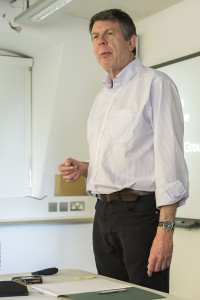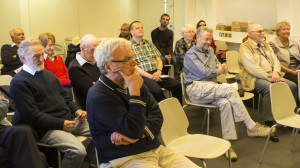April 20, 2013
Flamsteed History of Astronomy Group – Inaugural Meeting
Mike Dryland
Report by: Mike Meynell
The inaugural meeting of the Flamsteed History of Astronomy Special Interest Group took place on Saturday 20 April 2013 in the South Building of the Royal Observatory Greenwich. Around twenty Flamsteed members ignored the beautiful weather conditions outside to help shape the direction of this new group, which is being led by Mike Dryland. The History of Astronomy is a topic which Mike is absolutely passionate about, as anyone who has been treated to one of his fascinating tours of the Royal Observatory will know. More than 60 Flamsteed members have already expressed an interest in participating in the group.
Mike encouraged attendees to think about any talks that members might like to give to the group, so that we could share our knowledge. To set the scene, Mike presented his own short talk about the seventh Astronomer Royal, Sir George Biddell Airy – entitled “What did George Airy ever do for us?”. Flamsteed member, and the man who made the last observation with the Airy Transit Circle at Greenwich, Gilbert Satterthwaite, has said that many of the procedures that were followed at the Greenwich Observatory in the 1950’s were those that Airy put in place a hundred years before. Gilbert has given a talk to the Flamsteed about George Airy in the past and the report can be found here. The Flamsteed society had trip to Airy’s childhood home in 2005, when Jane laid a wreath on George’s grave on behalf of the society.
So, what did George Airy ever do for us? An extraordinary amount, as it turned out. Born in 1801, he showed a prodigious talent for mathematics and graduated as senior wrangler at Cambridge in 1823. He became the Lucasian Chair of Mathematics in 1826, before switching to astronomy and becoming the Plumian professor of astronomy in 1828. One of his main achievements of this era was providing a mathematical description of the diffraction pattern created by lens for a point source of light – a phenomenon now known as the Airy disk. His interest in optics, and the fact that he suffered from astigmatism, caused him to find a method for correcting this problem using cylindrical lenses. He strongly encouraged the building of the Northumberland Telescope in Cambridge. The design of the telescope mount will be familiar to all visitors to the 28-inch telescope at the Royal Observatory.
In 1835, he became the seventh Astronomer Royal, a post in which he remained for the next 46 years until his retirement in 1881. In this post, his incredible organisational skills came to the fore. It’s here that two of the most popular stories about George Airy are told: firstly that he would date and sign any blotting paper that he used and file it away for future reference and secondly that he was found in an observatory store room labelling empty boxes as ’empty’! However, his work on procedures at the observatory would be his lasting legacy, meaning that many of the tasks could be de-skilled and performed by human ‘computers‘. In addition, the expansion of the sunspot record was down to Airy as was the installation of the Airy Transit Circle which led to Greenwich becoming the Prime Meridian of the World in 1884.
It was Airy who presided over the adoption of standard time in Britain. Prior to this, different parts of the country kept their own local time. This, of course, changed completely after the introduction of railways, as they needed to use standard time in all parts of the country so that railway timetables could be set. Airy adopted electro-galvanic clocks so that time could be communicated across the country via telegraph.
As Airy’s reputation grew, he effectively became the chief consulting scientist to the government. As a result, he became involved in trying to solve many of the scientific problems of the day. These included:
- Finding a solution to the problem of using compasses in iron ships;
- Being one of the members of the government commission which set the standard railway track gauge for Great Britain;
- Acting as project manager for the installation of the Westminster Great Clock (colloquially known as “Big Ben”, though this is actually the name of the bell). This included a telegraphic link to the Greenwich Observatory;
- Designing an experiment to weigh the Earth using a pendulum (though this proved to be rather inaccurate).
There were some setbacks as well. When Neptune was discovered by the Berlin Observatory, using calculations from a French mathematician, there were many who questioned why the British had not made this discovery. As Astronomer Royal, Airy took a great deal of criticism for this from the press. However, he used this bad publicity to lobby for the installation of a large refracting telescope at Greenwich. This he eventually achieved, with the building of the Great Equatorial Building and the installation of the 12¾ inch Merz telescope in 1859. Later, this telescope was replaced by the 28-inch Great Equatorial Telescope in 1893, although the 28-inch uses the same English-equatorial mount that Airy had installed.
Airy retired in 1881 and died in 1892 at the age of 90.
This short talk was a real treat for all who attended and was a fitting launch to the History of Astronomy group.
The meeting continued with a discussion on the how the group should be run in the future.
Discussion on how the Special Interest Group should be run
Mike explained that the History of Astronomy group was the third Flamsteed special interest group, after solar observing and the radio astronomy group. The group would be open to all Flamsteed members and would be free of charge. Of course, if we organise trips, then there may be extra charges incurred. A separate mailing list is being maintained for those interested in the History of Astronomy group and if members wish to join this list, they we be advised to contact us.
Initial ideas for future talks have already been received. It was suggested that we meet 4 or 5 times a season. The issue of finding a suitable venue was discussed. As over 60 Flamsteed members have already expressed an interest in the group, the possibility of meeting in a local pub was less likely. However, the Royal Observatory Greenwich is open on Tuesday evenings during term-time up until 9pm. On Thursday evenings, we could meet at the National Maritime Museum until 8pm. We may also wish to get together for some daytime events, some at the weekends and some during the week (particularly if we are arranging special visits).
The backbone of the programme would be sharing knowledge amongst ourselves through members talks. There are many people who already have some talks prepared and we could arrange ‘club’ evenings where more than one talk takes place and members also share what they are working on. We may also be able to get some of the museum curators along for a talk. Visits to the reserve collection for the Royal Observatory and the Science Museum could also be arranged, as well as other places of interest (e.g. Museum of the History of Science in Oxford, the Institute of Astronomy in Cambridge, Stonehenge, the Royal Astronomical Society and the Royal Society, etc).
The group agreed that a visit to the Royal Observatory reserve collection at Kidbrooke should be our first priority for a visit, as it is local and should be easier to organise. This would be a wonderful opportunity to re-start the Flamsteed visits programme, which was a mainstay of the programme in the past. We will therefore pursue this for our first visit.
Jane raised the idea of campaigning to install a plaque at Lewisham station to commemorate the fact that it was the first station to have a telegraph link to the Greenwich Observatory, which heralded the introduction of standard railway time and thereby the standardisation of time for the whole of Great Britain.
It was agreed that a report of the meetings would be placed on the Flamsteed website for all to view along with links to background information. The first evening meeting will probably be arranged for a Tuesday evening, because we can start the meeting later and finish later. In order not to lose momentum, we would hope to arrange this within the next couple of months. Meetings in July and August will be avoided as attendance is usually too low due to the holiday period. However, we could arrange for gallery tours during this period.
There was no other business and the meeting was closed.
Pictures from the Meeting (by Mike Meynell):
Posted under: Flamsteed, History of Astronomy, Meeting Report







You must be logged in to post a comment.